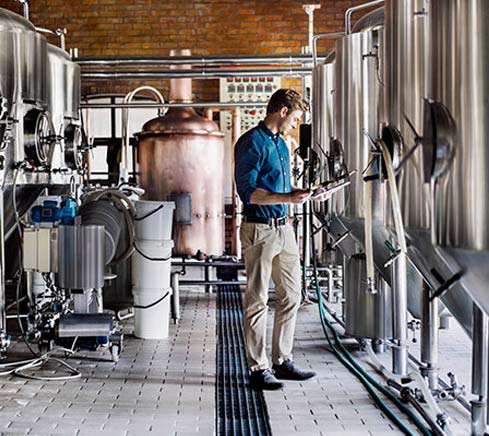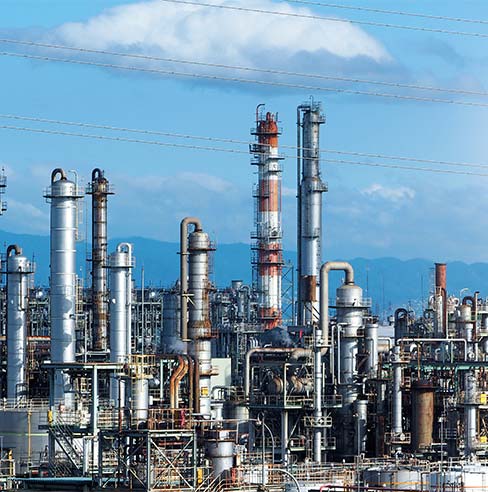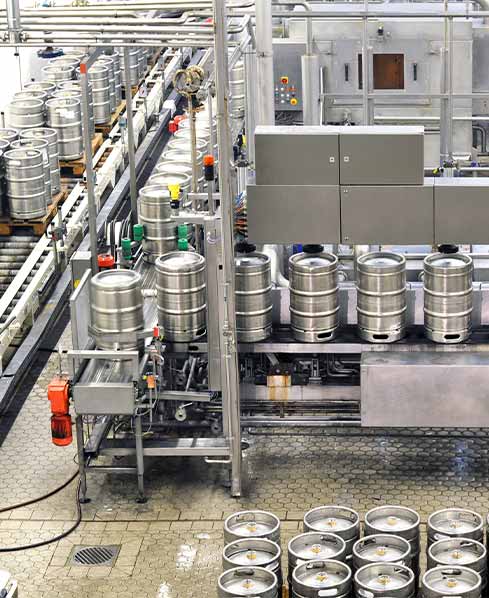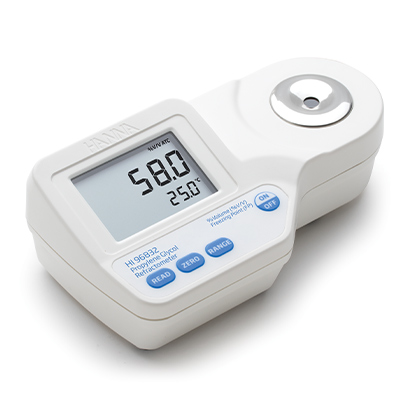Propylene glycol is used in glycol chillers and dispensing systems intended for food applications, such as beer and wine. Maintaining the appropriate percent of glycol is important in glycol chillers as too low of a percentage could lead to the system freezing and rupturing while too much glycol will reduce the systems efficiency.
The instrument converts the refractive index of a sample to percent volume or freezing point. These conversions are based on internationally recognized references for unit conversion and temperature compensation for glycol solutions (e.g. CRC Handbook of Chemistry and Physics, 87th Edition).

Temperature is the most critical parameter for consistency and quality maintenance.
Propylene glycol chillers are commonly used throughout the industrial processes to chill and regulate temperature.
Propylene glycol (glycol for short) is a food-grade antifreeze that can be used as part of a chilling system when a food or beverage product requires rapid cooling. Glycol chillers generally operate several degrees below the freezing point of water (0°C, 32°F), and require a strict 35% glycol to 65% water ratio that must be maintained and monitored throughout the life of the chiller.
A solution containing less than 35% glycol will cause the system to freeze and possibly rupture coolant lines; a larger concentration of glycol will reduce the efficiency of the chiller system.

Calculating the proper ratio of glycol to water in a refrigeration system depends on the coldest temperature you need during operation. If the refrigeration system is used indoors, where there is a lower chance of freezing, the amount of glycol required will be significantly less than a glycol chiller used outdoors.
Because the system utilizes glycol and operates at temperatures below 0°C, the freezing point must also be monitored to prevent damage.
Glycol chillers can be widely used in rubber, plastic, petroleum, chemical, electronics, paper, textile, brewing, pharmaceutical electroplating, central air conditioning and many other fields.
Breweries
Brewers use glycol chillers throughout the entire brewing process. Wort, the boiling-hot product from breaking down the starchy malted grain, must be cooled prior to fermentation. A glycol chiller can be used to cool the wort. Once the wort is in the fermenter is sufficiently cooled to room temperature, the yeast is pitched and fermentation begins.
Chilled glycol is used to maintain the ideal temperature for fermentation, which varies depending on the style of beer being brewed and strain of yeast. Cold crashing, a procedure performed once fermentation is complete, reduces the temperature rapidly and assists in clarifying the product by encouraging yeast and other suspended particles to settle and flocculate on the bottom. Crash cooling also results in the final holding temperature of the product, which is maintained during packaging and final product refrigeration.

Wineries

Winery chillers are used in the fermentation process of winemaking to control the temperature during fermentation.
Glycol is added to the water in order to lower the water’s freezing point, allowing the cooling medium to drop below freezing. This make the cooling system more responsive to temperature changes in your storage vessels, and makes it possible to bring the wine down to cold stabilization temperatures.
The temperature of the glycol solution varies depending on the type of wine being made and each winemaker’s preference, but most winery chillers operate in the 2°C to 10°C range (7°C to 15°C for wine containers).
DAIRY Industries
A properly designed dairy glycol chiller can cool the milk very rapidly to help keep milk temperatures (and bacteria growth) under control as it is transferred from the milking parlor to its insulated tank.

Digital refractometers are affordable instruments that enable spot checking whenever is needed.
In addition to the wide measuring range of propylene glycol from 0 to 100% (%V/V), the meter also provided measurement of the associated freezing point from 0 to -51°C (32 to -59.8°F).
Digital display and automatic temperature compensation is a significant upgrade from the manual refractometer measurements utilized in the past.
The digital refractometer eliminates the uncertainty associated with mechanical refractometers and is easily portable for use in the field.
The HI96832 Digital Refractometer utilizes the measurement of refractive index to determine the percent volume and freezing points of propylene glycol based solutions.
The HI96832 is an easy-to-use tool for measuring freezing point and percent volume in propylene glycol solutions, on the production floor or in the lab.
- Automatic Temperature Compensation
- 0 – 100% Volume range with ±0.3% accuracy
- 0 to -50 °C freezing point range with ±0.5 °C accuracy
- IP65 waterproof protection
- Automatic Temperature Compensation (ATC)
- Battery operation with Low Power indicator (BEPS)
- Automatically turns off after 3 minutes of non‑use
HI96832
Digital Refractometer for Propylene Glycol Analysis
The HI96832 is a rugged, portable digital refractometer designed for the measurement of percent volume and freezing point of propylene glycol based solutions. The HI96832 has a high accuracy of ±0.2% volume and ±0.5 °C freezing point and features simple operation that gives reliable results each and every time. All readings are automatically compensated for temperature variations and displayed with a 1.5 second response time. The sealed flint glass prism and stainless steel well are easy to clean. Just wipe with a soft cloth in preparation for the next sample.
Author:
Nives Vinceković Budor
mag.ing.chem.ing.
Nives Vinceković Budor
mag.ing.chem.ing.

With Great Product Come Great Results




